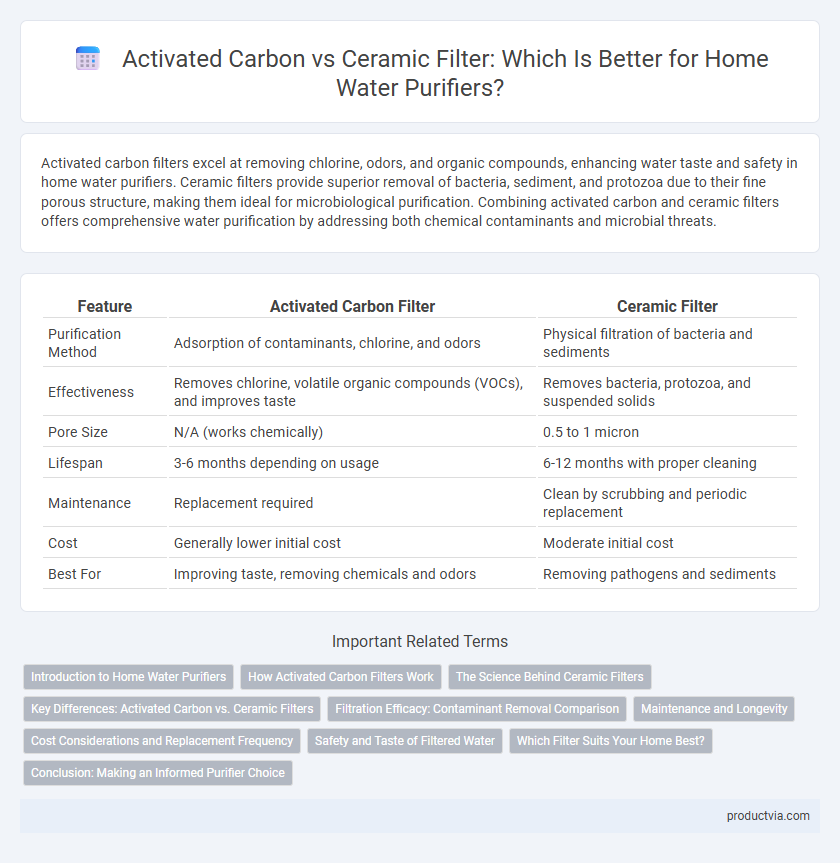Activated carbon filters excel at removing chlorine, odors, and organic compounds, enhancing water taste and safety in home water purifiers. Ceramic filters provide superior removal of bacteria, sediment, and protozoa due to their fine porous structure, making them ideal for microbiological purification. Combining activated carbon and ceramic filters offers comprehensive water purification by addressing both chemical contaminants and microbial threats.
Table of Comparison
| Feature | Activated Carbon Filter | Ceramic Filter |
|---|---|---|
| Purification Method | Adsorption of contaminants, chlorine, and odors | Physical filtration of bacteria and sediments |
| Effectiveness | Removes chlorine, volatile organic compounds (VOCs), and improves taste | Removes bacteria, protozoa, and suspended solids |
| Pore Size | N/A (works chemically) | 0.5 to 1 micron |
| Lifespan | 3-6 months depending on usage | 6-12 months with proper cleaning |
| Maintenance | Replacement required | Clean by scrubbing and periodic replacement |
| Cost | Generally lower initial cost | Moderate initial cost |
| Best For | Improving taste, removing chemicals and odors | Removing pathogens and sediments |
Introduction to Home Water Purifiers
Home water purifiers utilize activated carbon and ceramic filters as two common filtration technologies, each offering distinct benefits. Activated carbon filters excel at removing chlorine, odors, and organic compounds, enhancing taste and chemical safety, while ceramic filters provide superior removal of bacteria, protozoa, and suspended particles through their microscopic pore structure. Selecting between activated carbon and ceramic filters depends on specific water quality issues and purification needs within a household.
How Activated Carbon Filters Work
Activated carbon filters work by adsorbing contaminants through a highly porous surface that traps chlorine, volatile organic compounds (VOCs), and harmful chemicals, improving taste and odor in home water purifiers. These filters use activated charcoal made from materials like coconut shells or coal, which create millions of tiny pores that increase surface area for effective impurity removal. Unlike ceramic filters that physically block pathogens, activated carbon excels at chemical filtration, making it essential for reducing pollutants and improving water quality.
The Science Behind Ceramic Filters
Ceramic filters utilize a porous structure that physically traps bacteria, sediment, and other contaminants, effectively improving water purity without chemical additives. Their microscopic pores, typically ranging from 0.2 to 0.5 microns, block pathogens while allowing essential minerals to pass through, maintaining the water's natural taste. Unlike activated carbon filters that rely on adsorption to remove chlorine and organic compounds, ceramic filters emphasize mechanical filtration for microbiological safety.
Key Differences: Activated Carbon vs. Ceramic Filters
Activated carbon filters excel at removing chlorine, volatile organic compounds (VOCs), and improving taste and odor, while ceramic filters primarily target bacteria, sediments, and pathogens through physical filtration. Ceramic filters offer longer lifespan and can be cleaned and reused, whereas activated carbon filters require regular replacement once saturated with contaminants. Home water purifiers often combine both technologies to ensure comprehensive purification by addressing chemical contaminants and microbial impurities simultaneously.
Filtration Efficacy: Contaminant Removal Comparison
Activated carbon filters excel in removing chlorine, volatile organic compounds (VOCs), and improving taste and odor by adsorbing chemical impurities effectively. Ceramic filters provide superior filtration against bacteria, protozoa, and suspended particles due to their fine porous structure, physically blocking contaminants larger than 0.2 microns. For comprehensive home water purification, combining activated carbon with ceramic filtration offers enhanced contaminant removal, targeting both chemical pollutants and microbial pathogens.
Maintenance and Longevity
Activated carbon filters require regular replacement every 3 to 6 months to maintain optimal performance, as they can become saturated with contaminants, reducing their effectiveness. Ceramic filters, known for their durable and washable nature, can be cleaned periodically to remove trapped particles, extending their lifespan up to several years with proper care. Home water purifiers utilizing ceramic filters generally offer longer longevity and lower maintenance costs compared to activated carbon filters, making them ideal for sustained use.
Cost Considerations and Replacement Frequency
Activated carbon filters for home water purifiers typically cost less upfront but require replacement every 3 to 6 months due to limited adsorption capacity. Ceramic filters, though slightly more expensive initially, offer longer durability and can last up to 12 months or more before needing replacement, reducing long-term maintenance costs. Choosing between the two depends on balancing initial investment against ongoing replacement expenses and water quality needs.
Safety and Taste of Filtered Water
Activated carbon filters effectively remove chlorine, volatile organic compounds, and odors, significantly improving the taste and safety of filtered water by reducing harmful chemicals. Ceramic filters provide excellent microbial filtration, eliminating bacteria and protozoa to ensure safe drinking water, though they may not impact taste as strongly as activated carbon. Combining both filters can optimize water purity and flavor, offering comprehensive protection against contaminants and enhancing overall water quality.
Which Filter Suits Your Home Best?
Activated carbon filters excel at removing chlorine, volatile organic compounds, and unpleasant odors, making them ideal for improving taste and chemical contaminants in tap water. Ceramic filters provide superior filtration for bacteria, cysts, and sediment, offering mechanical filtration suitable for areas with biological contamination. Choosing the best filter depends on your water quality: opt for activated carbon if chemical pollutants dominate, or ceramic filters if microbial safety and sediment removal are primary concerns.
Conclusion: Making an Informed Purifier Choice
Choosing between activated carbon and ceramic filters for home water purifiers depends on specific water quality needs, as activated carbon excels in removing chlorine, odors, and organic compounds, while ceramic filters effectively eliminate bacteria and sediments. Consider the source of your water, common contaminants, and maintenance preferences to select the most suitable filtration technology. Evaluating these factors ensures optimal water purity, safety, and taste tailored to your household requirements.
Activated carbon vs ceramic filter for home water purifiers Infographic

 productvia.com
productvia.com